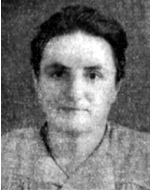Seltzer (Rice), Ada
Daughter of Rachel and Shmuel, was born on July 21, 1899 in the city of Khotin, in Serbia. Her father – a banker and agricultural owner – grew up with his other sons in terms of wealth and luxury. She studied at the Gymnasium in Khotin and studied chemistry and bacteriology at the universities of Cube and Odessa. She was full of life and initiative and had an artistic sense. She also studied handicrafts, sewing, weaving and knitting. Ada married her husband, a Russian refugee, and lived with him on an agricultural estate. Where she had a daughter, who died in infancy. After giving birth to her second daughter, Rachel, Ada left the estate, separated from her husband and moved to Czernowitz. Where she raised her daughter in the spirit of culture and art. Despite the worsening situation of the Jews in Romania, she was honored by her work. Upon the entry of the Russians into Romania, she worked for them in a chemical laboratory and chemically supervised canned produce, and won the recognition of the authorities. Upon the German occupation, in 1942, she was sent to concentration camps in Transnistria. She was tortured as a political prisoner until the end of the war. Before she could send her daughter to her sister in Israel. In 1945 she immigrated to Israel and met with her daughter, who was accepted to the university. In order to sustain herself, she first worked at Beit Hakerem as a nurse, from where she moved to Tel Aviv and then to Jerusalem. She acquired a weaving machine and earned her bread in her excellent and tasteful work, which was sought by many customers and by WIZO After much effort she got an apartment and thought that she would live with her only daughter (she called her a “bird of my soul”). The War of Independence began and the daughter enlisted in active service and traveled to the besieged Gush Etzion, where she also enlisted in the Haganah and worked as a nurse and nurse in isolated positions within the borders of Jerusalem. Her daughter (in the break-up to the Old City) tried to continue her service in the Hagana and worked in the hospital kitchen On the island, took care of the wounded with superhuman devotion day and night, and after three months of this strenuous work, under the conditions of the siege in the city, died on August 23, 1948. The Haganah headquarters announced that she was the death of ” And the wounded. “She was buried in Sheik-Bader A. On August 30, 1950, she was sent to eternal rest in the military cemetery on Mount Herzl in Yerushalayim.
